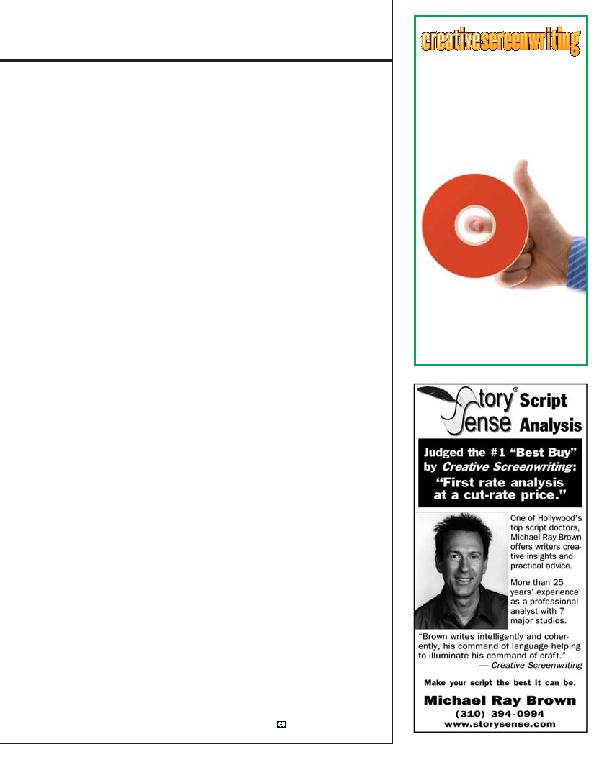
more understandable than the play," elabo-
rates director John Cameron Mitchell (Hed-
wig and the Angry Inch). "There's Nicole's
powerful platonic affair with this teenager
who was involved with the accident, which
to me is just the most surprising and pow-
erful part of the story -- only he can fully
understand the enormity of the situation,
and some kind of mutual absolution needs
to happen between them. Meanwhile,
Aaron's character, who is being pushed away
from his wife, finds solace and support with
this other woman."
believe is actually better than the play. There
are so many scenes that are hinted at in the
play that feel like a vital part in the screen-
play: Sandra Oh's character, the group ther-
apy scenes, the supermarket scene, the prom
scene, showing the house to the couple."
veloping the script for some time and settled
on a draft they were happy with. According
to Lindsay-Abaire, the fact that he was work-
ing with familiar characters made his screen-
writing a relatively fast process. "I wasn't
trying to squeeze stuff that I liked into the
movie, but I also wasn't trying to avoid
using things from the play," says the writer,
who began fresh, even going so far as to
conceive an all-new opening scene that tells
audiences all they need to know about
Becca's character. In the scene, she is gar-
dening -- an obsession along with cooking,
that helps her maintain a measure of con-
trol over her life -- and is interrupted when
a neighbor comes over and steps on one of
her seedlings.
to recycle choice lines or monologues ver-
batim, as with the near-perfect note on
which Rabbit Hole ends, now accompanied
by images. "We see the tendrils of hope
dramatized, instead of just talking about it,"
he explains.
Hole" from a poignant short story written
by Jason in the play to a comic for the film
-- a more cinematic option that serves as a
visual motif throughout. Another detail that
had to be rethought when translating the
to do with the intermission, which disguises
a gap of three or four months in the play.
"You don't want to feel like we stopped and
restarted," says Lindsay-Abaire, who tele-
scoped events to eliminate the interruption.
the final word on what ends up on stage, he
extended the same courtesy to Lindsay-
Abaire. "In film, writers are shunted as
quickly as possible to the side," the director
says. "But in this case, because it was his
baby and because he's a brilliant writer, I
wanted him to approve the shooting script,
which is pretty unusual for directors, who
want to piss all over it." When it came to
making revisions, Lindsay-Abaire explains,
"It wasn't actually rewriting, it was more
stripping away, making the script leaner. It
was just John saying, `Is this what you're try-
ing to get at with these three pages? Because
if so, I can do that in a shot.'"
scenes, replace some lines with images, re-
minding him that we could do a lot with
the camera." On-screen, a well-chosen
closeup could eliminate the need for an en-
tire monologue, which was exactly the op-
posite of the process Lindsay-Abaire had
faced on another of his assignments, co-
writing "Shrek the Musical" for Broadway.
"In the movie, they can move in on Shrek's
big, huge eyes, and people get it, but in the
balcony at the musical, that isn't possible,"
Lindsay-Abaire says. "So we had to come
up with songs that crack open the charac-
ter's heart and articulate what he's feeling."
Izzy (Tammy Blanchard), who originally
had a big part in the first act. Though
Mitchell believed that giving Izzy her own
scenes diverted attention away from Rabbit
Hole's true protagonists, Lindsay-Abaire con-
sidered Izzy's presence vital to the comedic
balance he was trying to maintain. "She had
a lot of funny stuff that I had seen kill in
front of a Broadway audience," says the
writer, who ultimately realized that Mitchell
had made the right call when he attended
the film's Toronto Film Festival premiere.
"The crowd laughed in all the right spots. It
didn't occur to me that I had written all this
new stuff that kept things from getting too
grave or serious."